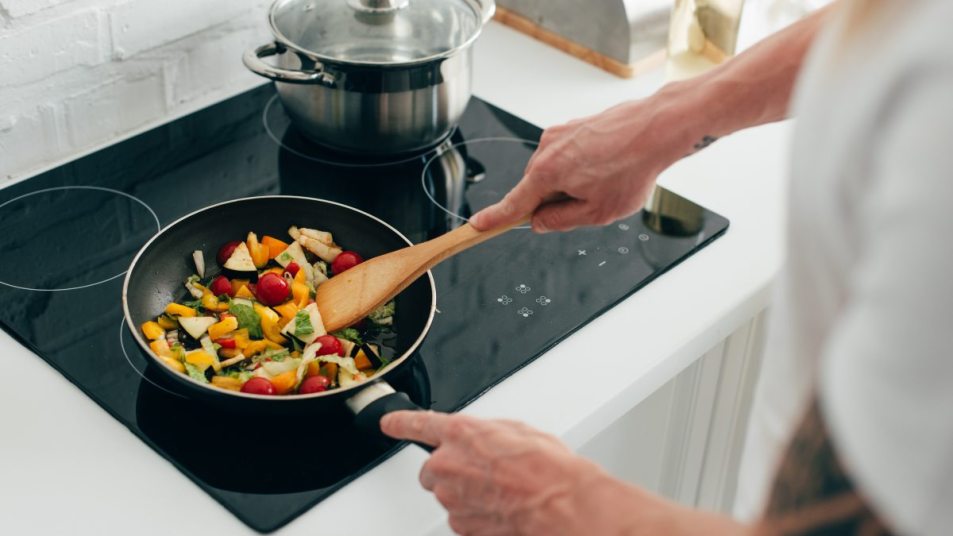Should You Make the Switch to An Electric Stove? Pros and Cons
A big change like this requires some extra research.

Gas stoves became bad news overnight. Recently, the internet has been abuzz about a study which found that indoor gas stoves correlate with a higher risk of asthma in children. In response to the research and evidence from other sources, The US Consumer Product Safety Commission (CPSC) decided to take a stand. The agency will consider a ban on new gas stoves, according to Bloomberg.com, and create regulations. It’s alarming news, to say the least — but what does it mean for the average American?
First, don’t panic and toss out your stove. To improve the air quality in your home right away, use your range hood every time you cook — even if it’s just a fried egg. Otherwise, crack a window or set up an air purifier. Now that the immediate concern is out of the way, it’s time to think about a long-term solution: electric stoves.
Getting an electric stove is a big switch. Some people love their ranges, while others long for the gas counterparts. How do you know if and when it’s time to make the change? Get the answers to these questions below.
Pros of Switching To an Electric Stove
There’s no sugar-coating it — installing a new appliance takes time and money. However, replacing a gas stove with an electric one may be worth the initial headache. Here’s why.
You could get an $840 rebate for a new stove.
Thanks to the Inflation Reduction Act, you could get a tax rebate of up to $840 for buying an electric stovetop and oven this year. The appliance must be Energy Star certified, so visit EnergyStar.gov to find out if your product qualifies. You may also be eligible for the following rebates (these are the maximum amounts possible — the max isn’t guaranteed):
- $500 for contractors to help install the oven
- $1,600 for insulation, air sealing, and ventilation
- $2,500 for upgrades to your home’s electrical wiring
- $4,000 for an upgrade to your electric load service center (the box that holds your circuit breakers)
The rebate amounts you can claim on your tax return at the end of the year depend on local laws. For more help, visit RewiringAmerica.org which calculates an estimate based on your zip code.
Note: Live in an apartment? Mention the rebates to your landlord. Apartment buildings also qualify for tax refunds.
It cooks better than you think.
Older electric stoves and cooktops are notorious for unsteady temperatures and slow heat-up times. Newer models, however, have improved tremendously. If you’re still not convinced, induction stovetops are another option.
How do induction stovetops work? Each element creates a magnetic current with the metal pan that rests on top of it, causing the pan to heat quickly and efficiently. Plus, induction reduces the risk of burns, because the rest of the cooktop stays cool to the touch. The one downside: You will need induction-friendly pans and pots. (The bottom of the pot or pan will usually say “induction” somewhere. You can also do a quick test by holding a magnet to the pot bottom; if the magnet sticks, the pan will work.)
It’s easy to clean.
Electric and induction stovetops are flat, because there’s no need for metal prongs that stand above an open flame. As a result, cleaning is very easy. Wipe the stovetop clean as you would a counter, using a damp cloth or sponge.
Evidence shows that it’s safer for you and your family.
It’s important to think of electric ovens as not just eco-friendly, but safer, too. Consumer Reports conducted 24 tests on two gas stoves in October 2022, and found that both stoves emitted elevated levels of nitrogen oxide. Nitrogen oxide is a highly-reactive gas that can irritate airways, aggravating asthma and increasing the risk of respiratory infections. While any sort of indoor cooking is linked to breathing issues (that’s why you should ventilate your kitchen every time you cook!), electric stoves at least aren’t releasing nitrogen oxide.
Cons of Switching to an Electric Stove
Though electric stoves are clearly safer, there are some downsides to consider before making this big purchase.
Electric and induction stovetops don’t keep even temperatures (in my experience).
Electric stoves have progressed leaps and bounds in the past 10 years, but in my experience, they still don’t compare to gas stoves. I’ve used some variation of an electric stove my entire life, and I have to admit: They can be frustrating. The electric stovetops I’ve used take a long time to heat up and a long time to cool down.
The latest edition in my home is a Samsung induction stovetop, and it’s much better. It heats up quickly and has a “rapid boil” setting (which I love for pasta night). The oven also has an air-fry mode. Like electric stovetops, however, the elements cool down very slowly once they’ve been on high heat; also, the temperature is not as even as it would be on a gas stove.
Still, these small annoyances aren’t enough to make me switch to a gas stove, especially when you consider recent headlines. For me, the pros outweigh the cons.
If you buy an induction cooktop, you’ll need induction cookware.
As previously mentioned, induction stove tops require induction-friendly pots and pans, which are made with magnetic material. If none of your cookware is induction friendly, you will need to buy new pots and pans. Electric stovetops don’t need special cookware, though you will want your pots and pans to have non-scratch features.
The Bottom Line
While there’s no need to panic, recent research and possible bans on gas stoves are cause for some concern. The latest improvements to electric and induction stoves have made cooking without gas easy and enjoyable — so, when you’re ready to replace your stove, we suggest that you look into electric options.
















